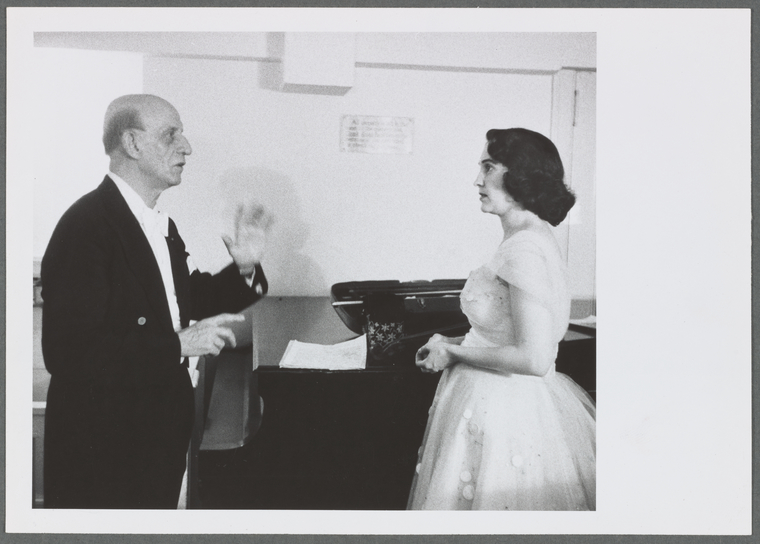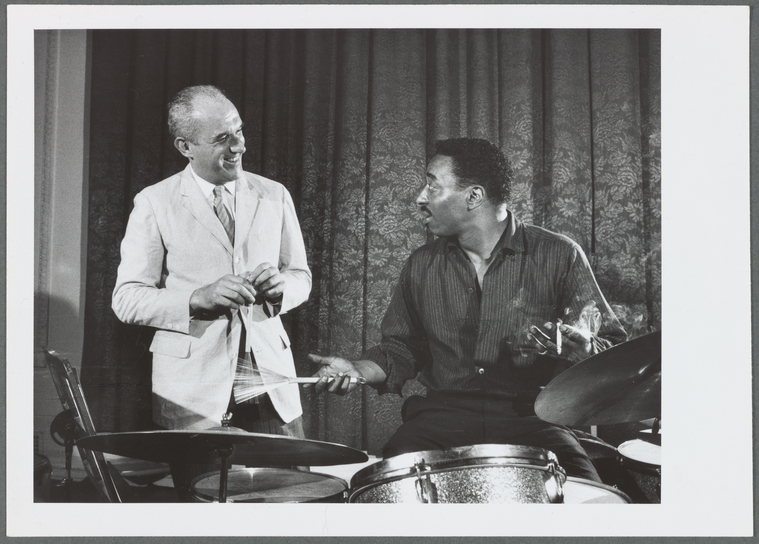Music For Moderns at Town Hall, 1957

During the 1950s, the producer George Avakian, director of both the Popular Album and International Departments of Columbia Records, was recording and releasing vast amounts of music from numerous and varied artists, including Louis Armstrong, Duke Ellington, Miles Davis, Mahalia Jackson, Dave Brubeck, Lotte Lenya, Erroll Garner, Tony Bennett, Benny Goodman, Buck Clayton, Edith Piaf, and Johnny Mathis. A few years earlier, he had also produced recordings by the composers John Cage and Alan Hovhaness.
Simultaneously, his wife, violinist Anahid Ajemian, was busy as a soloist and in a duo with her sister, pianist Maro Ajemian, performing and promoting new music from the likes of Cage, Hovhaness, Lou Harrison, Wallingford Reigger, and Henry Cowell, among others. Ajemian and Avakian began to notice their musical worlds overlapping more and more as jazz musicians became interested in composition, and performers began to become adept in both jazz and classical music. They also sensed audiences could be open to this cross-fertilization.
In 1957, at the suggestion of the publicist Alix Williamson, the couple co-produced a highly, perhaps even radically innovative four-concert series at Town Hall. Titled Music For Moderns, it brought together their friends and colleagues in jazz, classical, and gospel music. In an interview with Voice of America DJ Willis Conover, Avakian stated that the series was "designed to expand the listening pleasures of audiences who may not realize that both certain kinds of jazz and certain kinds of classical music can be presented on the same programs without any incongruity or loss of unified idea behind the programs."
The series brochure stated:
On the theory that most intelligent music-lovers actually have a considerably wider range of musical interest than they may realize, each of the programs in the MUSIC FOR MODERNS series will explore similar and contrasting uses of the same basic materials, thus extending, through logical relationships, the musical horizons of those familiar with only one aspect of the program content.
The opening night (April 28th) was titled “From Twelve Tone To Ellingtonia.” In the first half, Anahid Ajemian performed Kurt Weill’s Concerto for Violin and Wind Orchestra, Op. 12, with Dimitri Mitropoulos conducting. Though premiered in 1925, the piece was lost for some years before Lotte Lenya, Weill’s widow, re-discovered the score among his papers. Ajemian gave the piece its American premier and recorded It in 1955 for MGM, with Izler Solomon conducting.
The second half featured the Duke Ellington Orchestra in the world premiere of Ellington and Billy Strayhorn’s Such Sweet Thunder, a suite based on characters of William Shakespeare which had been commissioned by the Stratford Shakespeare Festival in Ontario, Canada. It is recognized today as one of the best of Ellington and Strayhorn’s extended works. The suite was later recorded for Columbia (produced by Irving Townsend), but this premiere performance, along with the Weill/ Ajemian/Mitropolous performance, was recorded, and the tapes are now held by the Rodgers and Hammerstein Archives of Recorded Sound in the George Avakian and Anahid Ajemian recorded sound collection.
The second night of the series, on May 12th, was titled “The Symbolic Sounds of Impressionism.” It featured the Modern Jazz Quartet performing John Lewis’s music for the French film Sait-on Jamis (No Sun In Venice); Claude Debussy’s Trio Sonata for Viola, Flute, and Harp performed by Walter Trampler, John Wummer, and Edward Vito; and Erik Satie’s Sports et Divertissements, performed by pianist William Masselos.
The latter was a multi-media event: Because the piece was written to accompany a set of 20 watercolor drawings by Charles Martin in 1913, Martin’s drawings were reproduced and projected at Town Hall, and the composer and writer Virgil Thomson recited his translation of Satie's preface and commentary on each of the 20 movements. Avakian referred to it as "the complete experience on three levels."
The third concert, on May 19th, was titled "Variations on the Folk Theme." Mahalia Jackson sang Gospel songs and spirituals in the first half, followed by Martial Singher, French baritone of Metropolitan Opera, singing European songs with folk origins.
The finale of the series on May 26th was called “New Dimensions.” The first half showcased the Chico Hamilton Quintet (Paul Horn, reeds, Fred Katz, cello, John Pisano, guitar, Carson Smith, bass, and Hamilton, drums) performing a set of world premieres written for this program, one of which, Concerto Petite, by Fred Katz, featured Anahid Ajemian guesting with the group. Hamilton’s set was recorded by Pacific Jazz, but not released in full until Mosaic Records' 1997 issueThe Complete Pacific Jazz Recordings of the Chico Hamilton Quintet.
In the second half, the composer Carlos Surinach conducted a group of three pieces for percussion orchestra: Carlos Chavez’s Toccata for Percussion, Alan Hovhaness’s October Mountain (a world premiere); and Surinach’s own Ritmo Jondo. (The Avakian/Ajemian collection holds a recording of this portion of the concert.)
Music For Moderns received good audience feedback and reviews, although Ajemian and Avakian lost money on the venture. Nevertheless, they made history: it was one of the first times that such an extensive and adventurous blending of musical worlds was presented in the United States, or possibly anywhere, and not just for one night, but for four. These programs still look ground-breaking in 2016; they demonstrate a trust in the audiences, and an assumption that they could digest and find value in music they did not know, an astonishing concept for many in 1957, and one still worth considering.

The exhibition "Music For Moderns": The Partnership of George Avakian and Anahid Ajemian, is on view in the Vincent Astor Gallery of The New York Public Library for the Performing Arts through September 24.
Read E-Books with SimplyE
 With your library card, it's easier than ever to choose from more than 300,000 e-books on SimplyE, The New York Public Library's free e-reader app. Gain access to digital resources for all ages, including e-books, audiobooks, databases, and more.
With your library card, it's easier than ever to choose from more than 300,000 e-books on SimplyE, The New York Public Library's free e-reader app. Gain access to digital resources for all ages, including e-books, audiobooks, databases, and more.
If you don’t have an NYPL library card, New York State residents can apply for a digital card online or through SimplyE (available on the App Store or Google Play).
Need more help? Read our guide to using SimplyE.




Comments
Unidentified figure in picture
Submitted by Marco (not verified) on June 8, 2020 - 6:54am